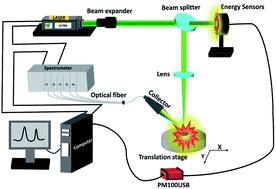当前位置:
X-MOL 学术
›
Anal. Methods
›
论文详情
Our official English website, www.x-mol.net, welcomes your
feedback! (Note: you will need to create a separate account there.)
Quantitative analysis of coal quality by laser-induced breakdown spectroscopy assisted with different chemometric methods.
Analytical Methods ( IF 2.7 ) Pub Date : 2020-06-15 , DOI: 10.1039/d0ay00905a Youjian Zhang 1 , Zhang Xiong 1 , Yiwen Ma 1 , Chenwei Zhu 1 , Ran Zhou 1 , Xiangyou Li 1 , Qing Li 2 , Qingdong Zeng 3
Analytical Methods ( IF 2.7 ) Pub Date : 2020-06-15 , DOI: 10.1039/d0ay00905a Youjian Zhang 1 , Zhang Xiong 1 , Yiwen Ma 1 , Chenwei Zhu 1 , Ran Zhou 1 , Xiangyou Li 1 , Qing Li 2 , Qingdong Zeng 3
Affiliation

|
Rapid and accurate measurement of coal quality has great significance for efficient use of coal at thermal power plants. Laser-induced breakdown spectroscopy (LIBS) combined with chemometric methods has many unique advantages in coal analysis. In this study, four calibration models, based on partial least squares regression (PLSR), support vector regression (SVR), artificial neural network (ANN), and principal component regression (PCR), were applied assisted by the LIBS technique for the quantitative analysis of coal quality. In order to find the optimal calibration method with LIBS for coal analysis, the spectral data of 40 standard coal samples with pressed-pellet pretreatment were acquired through a LIBS experimental setup, and the modeling efficiency and prediction accuracy of the four chemometric methods were compared based on these spectral data. As a result, the modeling efficiency of PLSR was found to be the highest, that of SVR was the lowest, and that of ANN ranked third. In terms of prediction performance, ANN was found to work better than the other three chemometric methods, and the average absolute error (AAE) of prediction of ash content, volatile matter content and calorific value were 0.69%, 0.87%, and 0.56 MJ kg−1, respectively. ANN can seek the best compromise of modeling efficiency and prediction accuracy and is demonstrated to be an optimal multivariate calibration method with LIBS for online measurement of coal quality at thermal power plants.
中文翻译:

通过化学诱导方法辅助的激光诱导击穿光谱法对煤质进行定量分析。
快速准确地测量煤炭质量对于在火力发电厂有效利用煤炭具有重要意义。激光诱导击穿光谱法(LIBS)结合化学计量学方法在煤分析中具有许多独特的优势。在这项研究中,LIBS技术辅助应用了基于偏最小二乘回归(PLSR),支持向量回归(SVR),人工神经网络(ANN)和主成分回归(PCR)的四个校准模型。煤质分析。为了找到使用LIBS进行煤分析的最佳校准方法,通过LIBS实验装置获得了40个经过压制球团预处理的标准煤样品的光谱数据,并根据这些光谱数据对四种化学计量学方法的建模效率和预测精度进行了比较。结果发现,PLSR的建模效率最高,SVR的建模效率最低,ANN的建模效率排名第三。在预测性能方面,发现人工神经网络的效果优于其他三种化学计量方法,其灰分,挥发物含量和热值的预测的平均绝对误差(AAE)分别为0.69%,0.87%和0.56 MJ kg-1。人工神经网络可以寻求建模效率和预测精度的最佳折衷方案,并被证明是一种利用LIBS进行火力发电厂煤质在线测量的最佳多元校准方法。
更新日期:2020-07-16
中文翻译:

通过化学诱导方法辅助的激光诱导击穿光谱法对煤质进行定量分析。
快速准确地测量煤炭质量对于在火力发电厂有效利用煤炭具有重要意义。激光诱导击穿光谱法(LIBS)结合化学计量学方法在煤分析中具有许多独特的优势。在这项研究中,LIBS技术辅助应用了基于偏最小二乘回归(PLSR),支持向量回归(SVR),人工神经网络(ANN)和主成分回归(PCR)的四个校准模型。煤质分析。为了找到使用LIBS进行煤分析的最佳校准方法,通过LIBS实验装置获得了40个经过压制球团预处理的标准煤样品的光谱数据,并根据这些光谱数据对四种化学计量学方法的建模效率和预测精度进行了比较。结果发现,PLSR的建模效率最高,SVR的建模效率最低,ANN的建模效率排名第三。在预测性能方面,发现人工神经网络的效果优于其他三种化学计量方法,其灰分,挥发物含量和热值的预测的平均绝对误差(AAE)分别为0.69%,0.87%和0.56 MJ kg-1。人工神经网络可以寻求建模效率和预测精度的最佳折衷方案,并被证明是一种利用LIBS进行火力发电厂煤质在线测量的最佳多元校准方法。











































 京公网安备 11010802027423号
京公网安备 11010802027423号